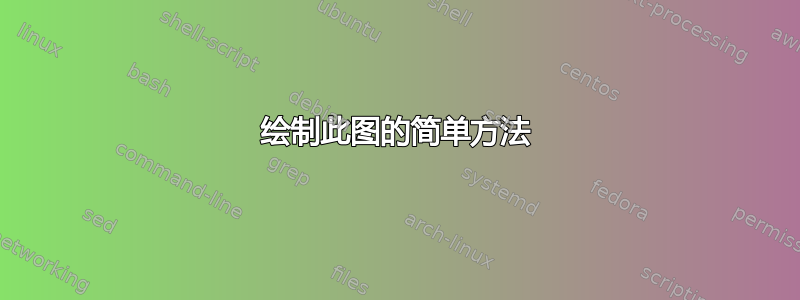
我正在使用 tikz 并想获得这张图片:
我的尝试:
\documentclass[a4paper,12pt]{book}
\usepackage{tikz}
\usepackage{tikz-cd}
\usetikzlibrary{arrows,patterns,snakes,fit,shapes.geometric,arrows.meta,decorations.markings,positioning,shapes,backgrounds}
\begin{document}
\begin{tikzpicture}
\pic {cuboid} node[left]{\simeq} (1,0,0)
\simeq \draw[dashed] (0,0,0) circle (1);
\draw[dashed] (-1,0,0) arc (180:360:1 and 0.6);
\draw[dashed] (1,0,0) arc (0:180:1 and 0.6);
\caption{Sample}
\end{tikzpicture}
\end{document}
真诚地感谢大家。
答案1
这是一个临时完成的。
\documentclass[tikz,border=3pt 3pt 3pt 3pt]{standalone}
\usetikzlibrary{calc}
\begin{document}
\begin{tikzpicture}
\def\Erad{2}
\def\Eang{20}
\def\Econ{1}
\coordinate (O) at (0,0);
\coordinate (A) at (0:\Erad);
\coordinate (B) at (180:\Erad);
\draw (O) circle (\Erad);
\draw (B) .. controls ++(-\Eang:\Econ) and ++(180+\Eang:\Econ) .. (A);
\draw[dashed] (B) .. controls ++(\Eang:\Econ) and ++(180-\Eang:\Econ) .. (A);
\coordinate (T1) at ($(O)+(3.5,-1.5)$);
\coordinate (T2) at ($(T1)+(2,0)$);
\coordinate (T3) at ($(T1)+(0,2)$);
\coordinate (T4) at ($(T1)+(2,2)$);
\coordinate (C) at ($(A)!0.5!(A -| T1)$);
% \fill[red] (C) circle (2pt);
\def\Cang{35}
\def\Clen{1.3}
\coordinate (T11) at ($(T1)+(\Cang:\Clen)$);
\coordinate (T12) at ($(T2)+(\Cang:\Clen)$);
\coordinate (T13) at ($(T3)+(\Cang:\Clen)$);
\coordinate (T14) at ($(T4)+(\Cang:\Clen)$);
\draw[dashed] (T1) -- (T11) -- (T12);
\draw[dashed] (T11) -- (T13);
\draw (T4) -- (T14) -- (T13) -- (T3)
-- (T1) -- (T2) -- (T12) -- (T14)
(T3) -- (T4) -- (T2)
;
\node at (C) {$\simeq$};
% \fill (T1) circle (2pt);
% \fill (T2) circle (2pt);
% \fill (T3) circle (2pt);
% \fill (T4) circle (2pt);
% \fill (T11) circle (2pt);
% \fill (T12) circle (2pt);
% \fill (T13) circle (2pt);
% \fill (T14) circle (2pt);
\end{tikzpicture}
\end{document}
答案2
再试一次,使用立方体的 3d 库:
\documentclass{article}
\usepackage{tikz}
\usetikzlibrary{3d}
\begin{document}
\begin{figure}
\centering
\begin{tikzpicture}[scale=1.5]
\draw (0,0) circle (1cm);
\draw (-1,0) arc (180:360:1 and 0.3);
\draw[dashed] (1,0) arc (0:180:1 and 0.3);
\node[font=\huge] at (1.7,0) {$\simeq$};
\begin{scope}[shift={(3,-0.4)}, scale=1.5]
\draw[dashed] (0,1,0) -- (0,0,0) -- (1,0,0);
\draw[dashed] (0,0,0) -- (0,0,1);
\draw (1,0,1) -- (1,0,0) -- (1,1,0) -- (0,1,0) -- (0,1,1) -- (0,0,1) -- cycle;
\draw (1,0,1) -- (1,1,1) -- (0,1,1);
\draw (1,1,0) -- (1,1,1);
\end{scope}
\end{tikzpicture}
\caption{This is a caption.}
\end{figure}
\end{document}
答案3
我认为 TikZ 对于这个图形来说已经足够了(球体和立方体是同胚的)。
这是一个有趣的渐近线解决方案。
// http://asymptote.ualberta.ca/
size(8cm);
usepackage("amssymb");
import three;
currentprojection=orthographic(4,1,-1,zoom=.8);
pen p=yellow+opacity(.5);
pen q=red;
triple A=1.5Y;
draw(shift(-A)*unitsphere,p);
draw(shift(-A)*unitcircle3,q);
draw(shift(A-(1,1,1))*scale3(2)*unitcube,p);
draw(shift(A-(1,1,0))*scale3(2)*unitsquare3,q);
label("$\simeq$",O);





